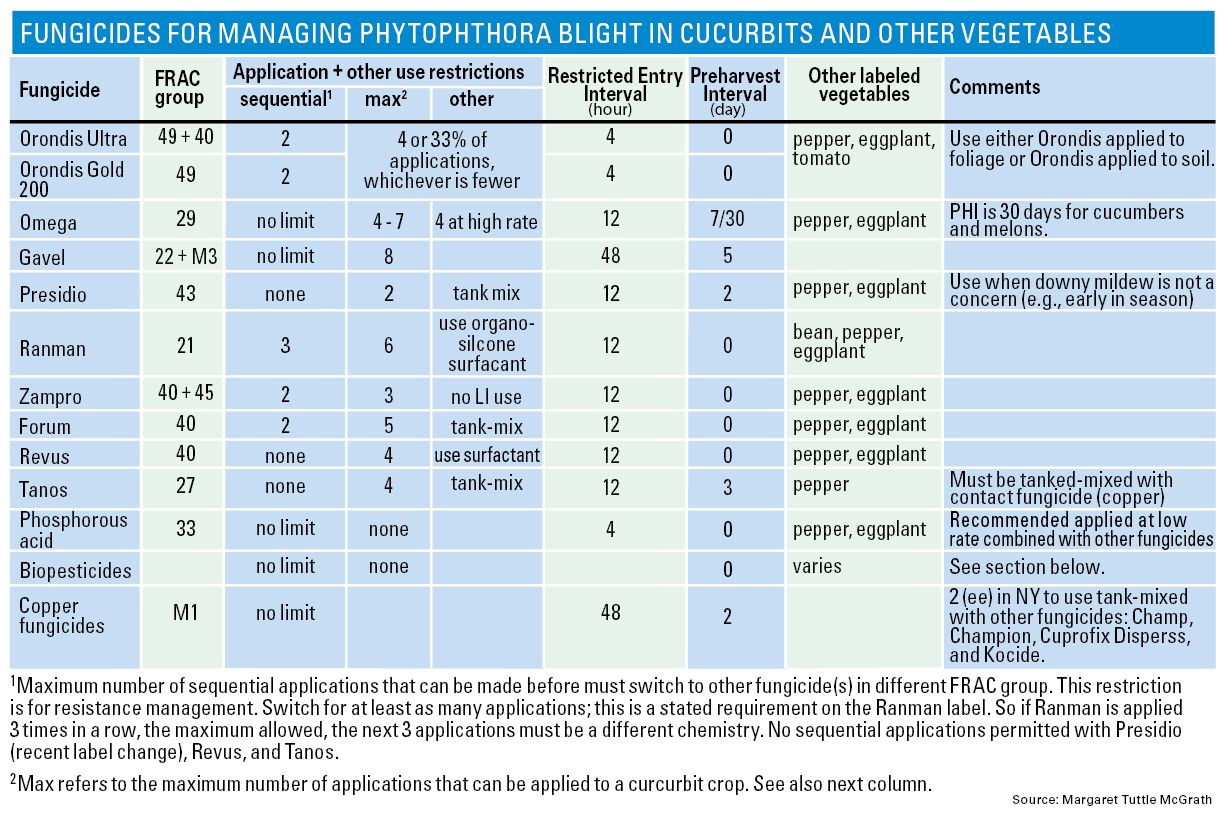Field Scouting Guide: Phytophthora
 This field scouting guide concentrates on Phytophthora capsici (Phytophthora crown rot or fruit rot). We’ve reached out to pathologists to learn how to spot and treat this pathogen.
This field scouting guide concentrates on Phytophthora capsici (Phytophthora crown rot or fruit rot). We’ve reached out to pathologists to learn how to spot and treat this pathogen.
Our contributors include: Amanda Gevens, University of Wisconsin-Madison; Margaret Tuttle McGrath, Cornell University; and Lina Quesada-Ocampo, Ph.D., North Carolina State University.
Basics
- Scientific name: Phytophthora capsici
- Common name: Phytophthora crown rot or fruit rot
- Geographical Range: Wherever susceptible crops are grown
- Crops affected: Cucurbits (cucumber, cantaloupe, watermelon, pumpkin, squash), solanaceae (pepper, eggplant, tomato), legumes (snap bean and soybean), and cocoa pod.
Pest Impact
Gevens: Phytophthora crown and fruit rot has been a disease of growing concern for 20 years in Wisconsin. Growers know of this pathogen in soils and take great care in limiting its spread. Growers carefully managed fields with a known history of this pathogen preventively. However, years with higher temperatures and rainfall can result in losses of portions of, or entire, fields of susceptible crops. Managing phytophthora crown and fruit rot can be intensive and expensive. And it requires many integrated approaches, including cultural as well as chemical.
Globally, wherever vegetables are grown, this disease can be problematic. Wisconsin has a significant commercial pickling cucumber crop as well as more minor acreage-susceptible crops.
It’s hard to monetize the actual impact, given the cost of management inputs and variable disease setbacks over time. Larger processing cucumber acreage in Wisconsin is just under 6,000 acres and, in 2017, was valued at roughly $11 million.
Typically, initial infection in a field produces symptoms on plant crowns and lower stems. These bear spores, further spreading the disease within areas of a field. P. capsici doesn’t typically move long distances on air currents.
McGrath: It is a problem throughout the Northeast. Many growers have the pathogen on their farms; some have managed to escape having it introduced. A total crop loss can occur. Phytophthora can start early in crop development, killing seedlings by causing crown rot. It’s possible symptoms appear only after fruit appears. That typically happens in unfavorable (dry) conditions during most of the growing season, or when a grower has implemented a good management program. Also, cucumber foliar tissue is not as susceptible as other crops. So for that crop, Phytophthora commonly affects only the fruit.
Quesada-Ocampo: Many counties in North Carolina report P. capsici‘s presence, especially those with significant commercial vegetable production. Several U.S. states report its presence, including, but not limited to:
- New Mexico
- California
- Colorado
- Florida
- Arizona
- New York
- New Jersey
- North Carolina
- South Carolina
- Michigan
- Illinois
- Arkansas
- Hawaii
- Kentucky
- Louisiana
- Massachusetts
- Ohio
- Oklahoma
- Tennessee
- Texas
Some melon growers in our state with infested fields have experienced losses as high as $1 million in a year due to P. capsici outbreaks.
Indentification
Gevens: Because the pathogen causing Phytophthora crown and fruit rot can infect plants at nearly all crop stages, the disease can be mistaken for one or more soilborne diseases such as Pythium, Rhizoctonia, Fusarium, or Verticillium. It can also be mistaken for one or more of abiotic disorders or conditions that result in damping off, vine or stem decline, or fruit rot, such as blowing sand and physical/mechanical plant damage, or water damage resulting in root malfunction.
McGrath: It can also be mistaken for white mold and bacterial wilt.
Quesada-Ocampo: If a grower suspects Phytophthora, it is always recommended to send a sample to a plant disease clinic for confirmation since visual inspection of the plant may not be enough to conclusively diagnose the pathogen. Bacterial wilt and southern blight of pepper show signs, such as oozing and sclerotia, respectively, that can usually be differentiated from Phytophthora by a trained pathologist.
Recommended Treatment for the Midwest
Gevens: The best recommendation is to avoid introducing the pathogen into your field. It is not seedborne; however, movement of infected plant parts and infested water or soil can effectively introduce the pathogen to a new location. For these reasons, it is critical that culled, infected fruit are not land-dispersed as a mechanism for disposal, even in northern regions that experience more extreme freezing conditions.
Phytophthora crown and fruit rot is caused by a pathogen that is not a true fungus, but a group of plant pathogens refer to as water molds. These pathogens are classified as oomycetes and have unique cellular and behavioral attributes when compared to fungal pathogens.
For these reasons, there are some unique fungicides and approaches that are effective for Phytophthora crown and fruit rot management that are not effective for other diseases caused by true fungi.
The pathogen produces three distinct spore types, each well-adapted with a unique role in epidemiological function. The oospore is the most durable of the spore types and is the long-term survival in the soil environment in and outside of plant tissue. The oospores are spherical and have a thick wall that provides resistance against adverse conditions such as extreme temperature and moisture. The sporangia are the in-season spreaders of the disease, apparent by their discernibly white and powdery presence on plant surfaces.
Organic treatments have demonstrated less success in managing this aggressive Phytophthora. However, treatments including copper can provide control of plant-to-plant spread. OxiDate (BioSafe Systems), or other treatments including hydrogen peroxide, can aid in limiting overall inoculum. With hydrogen peroxide, there is no residual control provided with application. The treatment may kill some spores on contact, limiting inoculum levels.
The pathogen can develop resistance to single-site mode of action fungicides. Carefully watch the plant’s response after applying single site mode of action fungicides to best understand pathogen population sensitivity to a given fungicide. Several applied plant pathology labs around the U.S. conduct pathogen fungicide resistance screens and may be helpful in characterizing populations for commercial producers.
Recommended Treatment for the Northeast
McGrath: While this disease is caused by a pathogen that can survive in soil, crop rotation is not an important management practice. I have seen several situations where Phytophthora blight started to develop first or became more severe in fields where susceptible crops had not been grown for several years, most notably at the research station where I am located and have been keeping records of this disease’s occurrence. This may reflect the pathogen’s ability to survive for years in the absence of a host crop plant, as its resting spore (oospore) or on roots of susceptible weeds, which include purslane, or the ease with which the pathogen can be moved such as on farm equipment and the pathogen’s ability to multiply quickly by producing an enormous number of spores.
Where I am (Long Island), I know growers who unsuccessfully tried to escape Phytophthora blight by renting land that had been in sod production for many years and had no record of Phytophthora blight occurrence. I also know a grower who has been able to successfully manage this disease (minimal loss) in his field where he has been growing Halloween pumpkins continuously for more than 20 years.
Several growers have adopted biofumigation using a mustard cover crop variety selected for this purpose. See our online guide to this disease.
There are several things you can do to control P. capsici to complement crop protection approaches:
- Plant tolerant varieties in infested fields. Some commercial peppers have been found to be less susceptible.
- Manage water by planting in well-drained and flat fields. Using raised beds and plastic mulch will reduce the chances of having standing water for prolonged times or having soil splash onto plant parts during a rain event. Using pathogen-free water is critical for management of this pathogen. Surface water can become infested and well or city water is preferred for irrigation. Some growers with infested surface irrigation water as their only irrigation option, have successfully installed a filtering and chlorination system to treat the water and eliminate this source of inoculum.
- Clean equipment after working in an infested field to avoid moving the pathogen into new fields. Rotate crops to non-hosts, such as cereals, for at least three years if the field is infested.











